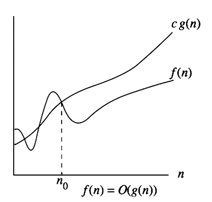Big - Oh Notation
Asymptotic Upper Bound
O (g (n)) = { f (n) : $ constants c, n0 ' 0 £ f (n) £ c g
(n) " n ³ n0
 from Cormen figure 2.1 from Cormen figure 2.1
If f (n) = Q ( g(n) ) then f (n) = O ( g(n) ) -- but not the other way around. F (n ) = n2 + 3 is Q ( n2
), and O ( n2 )and O ( n3 ) but not Q ( n3 )
Since "Big - Oh" is an upper bound, it is often used to state the complexity of a worst case analysis. Thus insertion sort is O ( n2 ). Note that the worst case bound of Q
( n2 ) is not a bound on the running time for every input
| 






